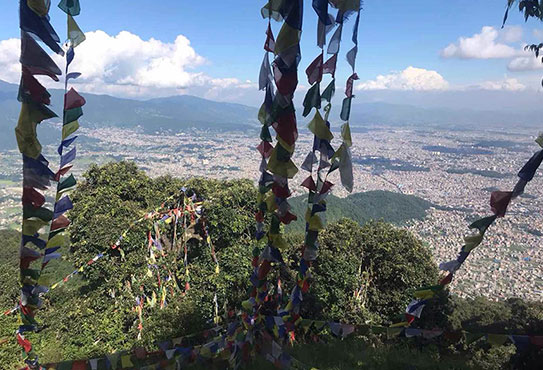Sunday - Friday: 9 AM - 4 PM
Shivapuri Hill, guarding the northeastern horizon of Kathmandu Valley, is one of the most important watersheds to Kathmandu Valley and its river system. This hill area was established as a protected watershed and wildlife reserve in 1976 and later merged/extended with the Shivapuri-Nagarjuna National Park and gazetted as a ninth national Park of Nepal in 2002. The area is full of fauna and flora but is still one of Kathmandu’s least hiked areas.
Breakfast at the hotel. At the indicated time, your guide and driver will reach your hotel. Then, drive 25 minutes northeast of Kathmandu and reach Buddha Neelkantha, one of the famous religious sites of Kathmandu Valley for Buddhist and Hindu flowers. We stop here to pay a visit to the holy place.
Buddha Neelakantha or Nneelkantha Buddha is a grand temple situated at the foot of Shivapuri Hill. Translated as “blue-throat Buddha”, it gained renown for possessing a remarkable sculpture cast in the image of the Chenrezig in Buddhist or Vishnu in Hindu. Said to have been made from a single block of rock, it is placed serenely in the middle of a pond, giving one the impression that it is floating on water. The Neelakantha Lokeshwara is one among the 108 forms of Bodhisattva Avalokiteswara.
While it is believed to date back more than 1,300 years ago, the exact nature of its origin is uncertain. The mythical story goes that King Suryaketu commissioned the statue’s creation, but an earthquake buried it underground. It was later rediscovered, excavated, and restored only after being seen in a vision by King Dharmagat.
Being a statue of a Buddhist deity, the later kings of Nepal, who were already converted to Hindu, ironically self-forbade them from even laying their eyes upon it, which gives rise to a rumour that they will meet instant death if they do so. The belief/irony leads King Pratap Malla to commission a replica of the Balaju water garden without consent from the gods or priests.
It lies on the coils of the great snake Ananta, a cosmic being whose 11 heads protect the image’s head. Besides, the statue’s four hands hold the club’s symbols, signifies knowledge, the chakra disc, the representation of the mind (In Buddhism is the wheel of Dharma), the conch, elements of the earth and a lotus flower, which symbolizes the universe (In Buddhism the compassion and purity). An interesting note is that the forehead of the statue, including the head crown, gets perpetually covered with cloth or flowers, and it is forbidden for anyone to see. In fact, up until today, no one has any idea what lies beneath those covers! Some say that the image of Buddha and other Buddhist deities is carved on the inner crown because it is also called Neelkantha (Shiva). The traditional practice of Shiva’s image is not complete and sacred without Buddha’s image on his head.
Lord Vishnu is believed to have been created from the idols of Bodhisattva and Avalokiteshvara. Idols of Bodhisattva Padmapani are very famous in Buddhist religious paintings found, including in the ancient caves of Ajanta and many other Buddhist caves.
Bodhisattva Padmapani holds the qualities of Tathagat Buddha, the same qualities and characteristics can also be seen in the idols of Bodhisattvas. Such as the Lotus is the symbol of peace/compassion/purity, and the idols of Padmapani hold the Lotus in hand, showing the compassion of Tathagat Buddha.
Tathagata Buddha, Avalokiteshvara, and Bodhisattvas statues have their own history. But Lord Vishnu has no history of his own and believed that he is only a character created from imagination, created from the idols of Bodhisattva and Avalokiteshvara and represents a Bhodisattva of his time. Bodhisattvas, who come in many Mahayana/Vajrayana formulas, are worshipped differently in the Brahmin religion today. But these preachers of Buddhism preach the Dhamma of the Buddhist faith in all formulas. Their sculptures, formulas, and mantras are archaeological evidence and are still vastly found in Mahayana Buddhist countries.
After visiting this great site, we continue toward the National Park gate, where we leave the vehicle and get checked into the National Park Area, registering our names and paying the entry permit fees. The excursion immediately starts through a dense and shaded forest area. As we gain altitude, a charming scene of Kathmandu Valley attracts us for several stops. We get surprised by the difference in how quickly we are out of the Kathmandu crowd and into serene nature, with fresh air full of oxygen and natural scent, birds, monkeys, other shy wildlife and sparse villages with smiley villagers. We finally reach a Buddhist nunnery, Nagi Gonpa, located on a hilltop 2325 metres above sea level with a beautiful view of Kathmandu Valley. The site is famous for Yoga trips; visit the monastery and rest.
Another 2-hour hike put us on top of the Shivapuri hilltop. Weather permitting, there are beautiful sceneries of Langtang and Ganesh Himal mountains. We stop here for our packed lunch and rest. We then take a short-cut trail, though a long walk down, to Buddha Nil Kantha and drive back to our hotel. Arrive at your hotel and be free on your own.


